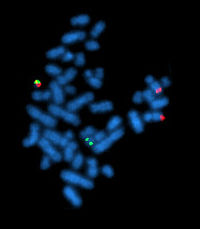
The structure of myeloid cell‐specific TNF inhibitors affects their biological properties
Sign Up to like & getrecommendations! Published in 2020 at "FEBS Letters"
DOI: 10.1002/1873-3468.13913
Abstract: Spatial organization and conformational changes of antibodies may significantly affect their biological functions. We assessed the effect of mutual organization of the two VHH domains within bispecific antibodies recognizing human TNF and the surface molecules… read more here.
Keywords: tnf; specific tnf; structure myeloid; myeloid cell ... See more keywords

miR‐223 promotes regenerative myeloid cell phenotype and function in the demyelinated central nervous system
Sign Up to like & getrecommendations! Published in 2019 at "Glia"
DOI: 10.1002/glia.23576
Abstract: In the injured central nervous system, myeloid cells, including macrophages and microglia, are key contributors to both myelin injury and repair. This immense plasticity emphasizes the need to further understand the precise molecular mechanisms that… read more here.
Keywords: phenotype function; nervous system; central nervous; myeloid cell ... See more keywords

Depletion of Collagen IX Alpha1 Impairs Myeloid Cell Function
Sign Up to like & getrecommendations! Published in 2018 at "STEM CELLS"
DOI: 10.1002/stem.2892
Abstract: The trabecular extracellular matrix (ECM) forms a three‐dimensional scaffold to stabilize the bone marrow, provide substrates for cell‐matrix interactions and retain, present or release signals to modulate hematopoietic stem and progenitor cell development. However, the… read more here.
Keywords: myeloid cell; function; myeloid; cell ... See more keywords

Sympathetic Neuronal Activation Triggers Myeloid Progenitor Proliferation and Differentiation
Sign Up to like & getrecommendations! Published in 2018 at "Immunity"
DOI: 10.1016/j.immuni.2018.05.004
Abstract: Summary There is a growing body of research on the neural control of immunity and inflammation. However, it is not known whether the nervous system can regulate the production of inflammatory myeloid cells from hematopoietic… read more here.
Keywords: proliferation; myeloid cell; myeloid; sympathetic neuronal ... See more keywords

Dectin-1 limits autoimmune neuroinflammation and promotes myeloid cell-astrocyte crosstalk via Card9-independent expression of Oncostatin M.
Sign Up to like & getrecommendations! Published in 2021 at "Immunity"
DOI: 10.1016/j.immuni.2021.01.004
Abstract: Pathologic roles of innate immunity in neurologic disorders are well described, but their beneficial aspects are less understood. Dectin-1, a C-type lectin receptor (CLR), is largely known to induce inflammation. Here, we report that Dectin-1… read more here.
Keywords: autoimmune neuroinflammation; myeloid cell; card9 independent; cell astrocyte ... See more keywords

Prediction of Hot Spots at Myeloid Cell Leukemia-1–Inhibitor Interface Using Energy Estimation and Alanine Scanning Mutagenesis
Sign Up to like & getrecommendations! Published in 2018 at "Biochemistry"
DOI: 10.1021/acs.biochem.7b01048
Abstract: Myeloid cell leukemia 1 (Mcl1) is an antiapoptotic protein that plays central role in apoptosis regulation. Also, Mcl1 has the potency to resist apoptotic cues resulting in up-regulation and cancer cell protection. A molecular probe… read more here.
Keywords: energy; cell leukemia; myeloid cell; alanine scanning ... See more keywords

Understanding the Species Selectivity of Myeloid Cell Leukemia-1 (Mcl-1) Inhibitors.
Sign Up to like & getrecommendations! Published in 2018 at "Biochemistry"
DOI: 10.1021/acs.biochem.8b00626
Abstract: To test for on target toxicity of a new chemical entity, it is important to have comparable binding affinities of the compound in the target proteins from humans and the test species. To evaluate our… read more here.
Keywords: mcl; affinity; mcl inhibitors; myeloid cell ... See more keywords

Optimization of Potent and Selective Tricyclic Indole Diazepinone Myeloid Cell Leukemia-1 Inhibitors Using Structure-Based Design.
Sign Up to like & getrecommendations! Published in 2018 at "Journal of medicinal chemistry"
DOI: 10.1021/acs.jmedchem.7b01155
Abstract: Myeloid cell leukemia 1 (Mcl-1), an antiapoptotic member of the Bcl-2 family of proteins, has emerged as an attractive target for cancer therapy. Mcl-1 upregulation is often found in many human cancers and is associated… read more here.
Keywords: potent selective; indole diazepinone; selective tricyclic; cell leukemia ... See more keywords

From Inhibition to Degradation: Targeting the Antiapoptotic Protein Myeloid Cell Leukemia 1 (MCL1).
Sign Up to like & getrecommendations! Published in 2019 at "Journal of medicinal chemistry"
DOI: 10.1021/acs.jmedchem.9b00455
Abstract: Protein-protein interactions (PPIs) have emerged as significant targets for therapeutic development, owing to their critical nature in diverse biological processes. An ideal PPI-based target is the protein myeloid cell leukemia 1 (MCL1), a critical prosurvival… read more here.
Keywords: protein; cell leukemia; myeloid cell; mcl1 ... See more keywords

Myeloid cell nuclear differentiation antigen controls the pathogen-stimulated type I interferon cascade in human monocytes by transcriptional regulation of IRF7
Sign Up to like & getrecommendations! Published in 2022 at "Nature Communications"
DOI: 10.1038/s41467-021-27701-x
Abstract: Type I interferons (IFNs) are critical for anti-viral responses, and also drive autoimmunity when dysregulated. Upon viral sensing, monocytes elicit a sequential cascade of IFNβ and IFNα production involving feedback amplification, but how exactly this… read more here.
Keywords: ifn; cell nuclear; nuclear differentiation; interferon ... See more keywords

Quantitative immunohistochemical analysis of myeloid cell marker expression in human cortex captures microglia heterogeneity with anatomical context
Sign Up to like & getrecommendations! Published in 2020 at "Scientific Reports"
DOI: 10.1038/s41598-020-68086-z
Abstract: Current immunohistochemical methods of studying microglia in the post-mortem human brain do not capture the heterogeneity of microglial function in response to damage and disease. We therefore investigated the expression of eight myeloid cell proteins… read more here.
Keywords: marker; heterogeneity; expression; myeloid cell ... See more keywords